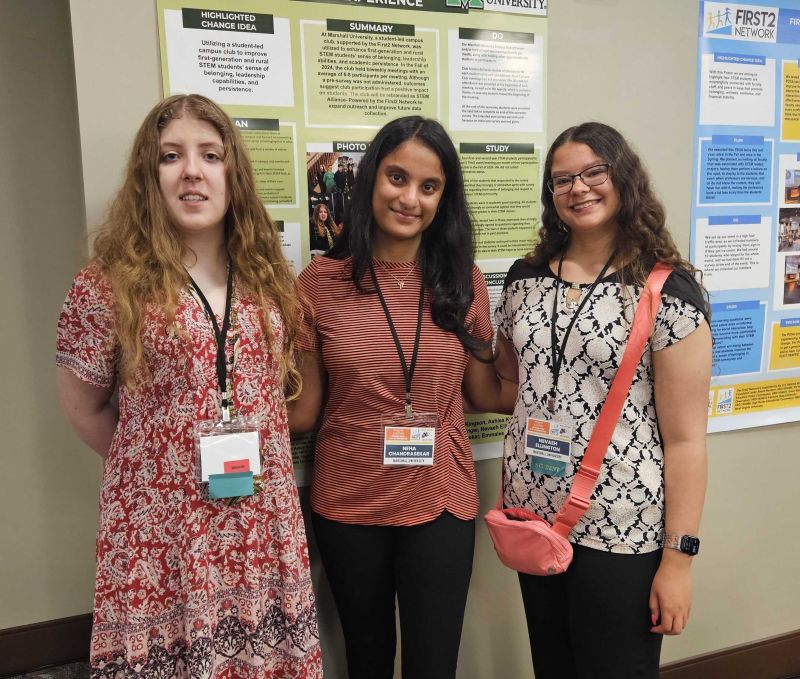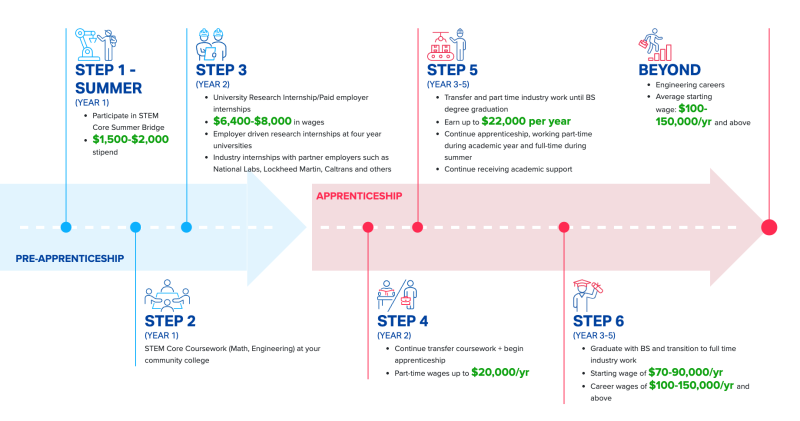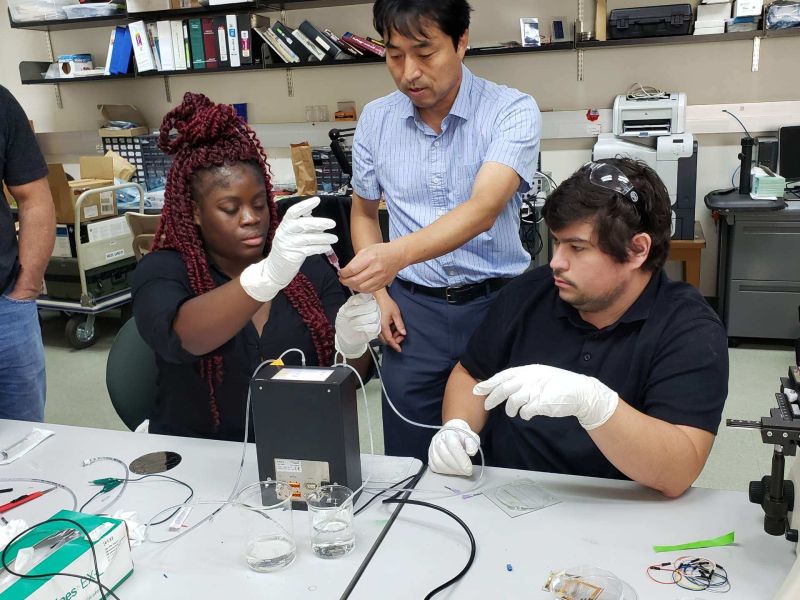Improving America's workforce: Promoting American prosperity through STEM education
How 3 networks and alliances are transforming STEM education, developing critical technologies and fueling economic growth and independence
Today, science, technology, engineering and mathematics fields are advancing rapidly and taking the economy with them. Fields like artificial intelligence, quantum computing and biotechnology have the potential to unlock massive economic benefits across society and throughout the United States.
To take advantage of these opportunities, the country needs a robust, well-educated workforce that makes the most of American potential in STEM. The U.S. National Science Foundation supports many different investments that are capitalizing on the American promise. These projects include the First2 Network, the STEM Core Alliance and the HBCU CHIPS Network.
Each of these projects is vital to boosting America's workforce and economy, as they target different areas of potential across the country.
Building a STEM talent pathway in rural communities
In West Virginia and nearby states, the First2 Network is working to enhance local economies by increasing the number of students pursuing successful STEM careers. The network partners with first-generation and economically disadvantaged students and faculty in rural communities to overcome educational challenges often seen in rural areas. This can include academic preparation for college courses and securing financial support.
Comprised of more than 1,200 members and 30 organizational partners — including students and high school teachers, colleges, universities, nonprofits and STEM industry partners — working together, the network enjoys broad local support. It's also seeing clear signs of success: while nearly 70% of first-generation students withdraw from college during their first two years, less than 30% of First2 STEM first-generation students withdrew.
"The First2 Network has been highly successful and has been used by other states as a model to improve the success of their students," said Luis Cubano, program officer in the NSF Directorate for STEM Education.
The First2 Network is bolstering the economy in Appalachia through building stronger relationships between universities and community colleges and West Virginia industry partners. By improving the retention of first-generation students through targeted support, the number of students graduating with STEM degrees is increasing. These students are then connected with potential employers through the WV Jobs Network and are thus more likely to pursue STEM careers in their communities, contributing to local economies and increasing median incomes.
Mastering mathematics for STEM careers
Mastering advanced mathematics can be a challenge for many students who want to pursue STEM. Additionally, students benefit from, but don’t always have access to, the support systems and financial resources needed for success in college.
The STEM Core Alliance addresses these issues through a combination of accelerated math course sequences, cohort-based learning and paid industry internships. The math course sequences help students become calculus-ready in just two semesters, while the cohort structure promotes peer learning, teamwork and self-efficacy. Industry internships provide students with practical applications for their education and on-the-job training that they can include on their resume, as well as financial resources that help them stay in school. The cohort and the internships combine to give students a strong STEM foundation and network, greatly increasing their likelihood of a STEM career.
"With NSF support, the STEM Core Alliance took the insight that mathematics was a bottleneck for entry into STEM careers plus the understanding of the value that paid internships would have to transform opportunities for hundreds of students and simultaneously to expand the STEM workforce," said Joseph Whitmeyer, program officer in the NSF Directorate for Social, Behavioral, and Economic Sciences. "They are an exemplar for the tremendous effects that a combination of innovative ideas, persistent commitment and funding judiciously applied can have."
The alliance includes several colleges and multiple industries, including power, construction and software companies (all essential to future economic growth), as well as national laboratories.
Ensuring semiconductor and microelectronics independence
From the Southwest to the Mid-Atlantic, a network of historically Black colleges and universities (HBCUs), including historically Black community colleges, in connection with Georgia Institute of Technology (Georgia Tech), is supporting the manufacturing of microelectronics in America. Through education, training and research, the HBCU CHIPS Network is working to expand America's microelectronics leadership and independence.
Most of the universities in the network have been involved in semiconductor manufacturing and microelectronics research for years, working in areas like device design, semiconductor materials, circuit integration and photonics. But through the network, they have been able to consolidate resources, leverage individual expertise and pursue greater opportunities. Pat Mead, engineering department chair at Norfolk State University, said the network provides a framework that can be duplicated across other communities. "The network is an example of how you can have a few centers of expertise come together and collaborate in a way that makes them stronger and has a real impact." The network also works with industry partners and collaborators, including Microsoft, Google, Micron and Boeing.
It's worth noting that the network has implications not just for economic prosperity, but also for national security. "The emphasis on national security cannot be understated," said George White, senior director for strategic partnerships at Georgia Tech. "I want to make sure that our men and women in uniform are at an advantage when going up against their adversaries, and microelectronics research can provide this military advantage."
Ensuring that America remains a leader in STEM research, discovery and innovation is vital to American prosperity. By supporting Americans from all walks of life to pursue education and career opportunities in STEM, NSF is continuing to invest in America's future.
About the Authors
Lenore K. Pedicord
Communications Specialist (Contractor)
Lenore K. Pedicord is a communications specialist (contractor) in the U.S. National Science Foundation Directorate for STEM Education, where she crafts stories to illustrate the impacts of improving science, technology, engineering and math education and accessibility for all. She is a former college professor and took inspiration for her approach to teaching (and her wardrobe!) from "The Magic School Bus," which she grew up watching, along with wildlife documentaries and the "Discovery Channel." Her master's research focused on how women in STEM are represented in film and the implicit messages surrounding their lives this gives to viewers, especially women and girls, along with the ways Hollywood can do better. She holds a bachelor's degree in environmental science and policy and a master's degree in science communication from George Mason University. In her free time, she enjoys reading, writing and traveling to find the best mountain range to retire near.
Caroline Kolar
Web Communications Writer and Media Specialist (contractor)
Caroline Kolar is a Web Communications Writer and Media Specialist (contractor) with the U.S. National Science Foundation. Her background is in content marketing and communications, which she applies to her work at NSF to ensure that the public is aware of the important (and very cool) research, technological developments, and societal contributions that science brings to the world. She works primarily with the Graduate Research Fellowship Program within the Directorate for STEM Education.




